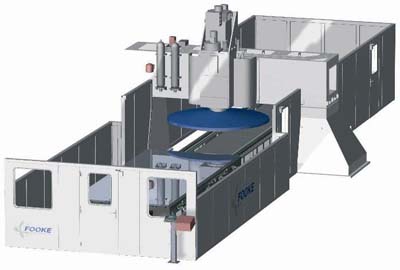
Distributed by Bohle Machine Tools Inc., the Endura 825 milling machine from Fooke GmbH is for machining large aluminum billets. "It is the 9'-dia., low-vibration milling cutter, the core of the new Fooke Endura 825 concept, which is what makes this machine unique for in the milling of aluminum billets," said Ludger Wellner, manager of the plant construction and material processing technology business section of Fooke. This gives the new Germany-made machine the capability to produce a high quality finish milling process, while greatly increasing the productivity, according to the company. The uses of this aluminum billet-milling cutter, machine symbiosis are found in the aluminum processing industries, where low stress cutting of homogeneous, fine-grained crystalline-structured materials with high finish requirements is necessary. For this the Endura 825 cuts aluminum billets up to 200mm (high) x 2,500mm (wide) x 6,000mm (long) (8" x 100" x 600"). The milling tool is made of cast steel and can mill different aluminum materials. Regardless of the required aluminum alloy material, the high accuracies in thickness tolerance, flatness, parallelism and surface finish, is consistent for each machining cycle. In addition to the improved technical requirements, the Endura 825 offers a modern safety concept, complying with the latest standards and current guidelines. Safety aspects, especially during loading and unloading of the workpieces, protect the operators while making it easier, faster and more reliable for the users to complete parts. The machine manufacturer is participating in a current research project of the European Union, in cooperation with the University of Hannover and the company Invent GmbH of Braunschweig, for the development of a milling cutter body made of fiber-plastic composites (CFRP). In the future, large milling cutters that are currently made of cast steel, will be reduced in weight and thus provide more optimized handling, according to Wellner regarding the current Fooke research project.
Contact Details
Related Glossary Terms
- composites
composites
Materials composed of different elements, with one element normally embedded in another, held together by a compatible binder.
- gang cutting ( milling)
gang cutting ( milling)
Machining with several cutters mounted on a single arbor, generally for simultaneous cutting.
- milling
milling
Machining operation in which metal or other material is removed by applying power to a rotating cutter. In vertical milling, the cutting tool is mounted vertically on the spindle. In horizontal milling, the cutting tool is mounted horizontally, either directly on the spindle or on an arbor. Horizontal milling is further broken down into conventional milling, where the cutter rotates opposite the direction of feed, or “up” into the workpiece; and climb milling, where the cutter rotates in the direction of feed, or “down” into the workpiece. Milling operations include plane or surface milling, endmilling, facemilling, angle milling, form milling and profiling.
- milling cutter
milling cutter
Loosely, any milling tool. Horizontal cutters take the form of plain milling cutters, plain spiral-tooth cutters, helical cutters, side-milling cutters, staggered-tooth side-milling cutters, facemilling cutters, angular cutters, double-angle cutters, convex and concave form-milling cutters, straddle-sprocket cutters, spur-gear cutters, corner-rounding cutters and slitting saws. Vertical cutters use shank-mounted cutting tools, including endmills, T-slot cutters, Woodruff keyseat cutters and dovetail cutters; these may also be used on horizontal mills. See milling.
- milling machine ( mill)
milling machine ( mill)
Runs endmills and arbor-mounted milling cutters. Features include a head with a spindle that drives the cutters; a column, knee and table that provide motion in the three Cartesian axes; and a base that supports the components and houses the cutting-fluid pump and reservoir. The work is mounted on the table and fed into the rotating cutter or endmill to accomplish the milling steps; vertical milling machines also feed endmills into the work by means of a spindle-mounted quill. Models range from small manual machines to big bed-type and duplex mills. All take one of three basic forms: vertical, horizontal or convertible horizontal/vertical. Vertical machines may be knee-type (the table is mounted on a knee that can be elevated) or bed-type (the table is securely supported and only moves horizontally). In general, horizontal machines are bigger and more powerful, while vertical machines are lighter but more versatile and easier to set up and operate.
- milling machine ( mill)2
milling machine ( mill)
Runs endmills and arbor-mounted milling cutters. Features include a head with a spindle that drives the cutters; a column, knee and table that provide motion in the three Cartesian axes; and a base that supports the components and houses the cutting-fluid pump and reservoir. The work is mounted on the table and fed into the rotating cutter or endmill to accomplish the milling steps; vertical milling machines also feed endmills into the work by means of a spindle-mounted quill. Models range from small manual machines to big bed-type and duplex mills. All take one of three basic forms: vertical, horizontal or convertible horizontal/vertical. Vertical machines may be knee-type (the table is mounted on a knee that can be elevated) or bed-type (the table is securely supported and only moves horizontally). In general, horizontal machines are bigger and more powerful, while vertical machines are lighter but more versatile and easier to set up and operate.
- tolerance
tolerance
Minimum and maximum amount a workpiece dimension is allowed to vary from a set standard and still be acceptable.






